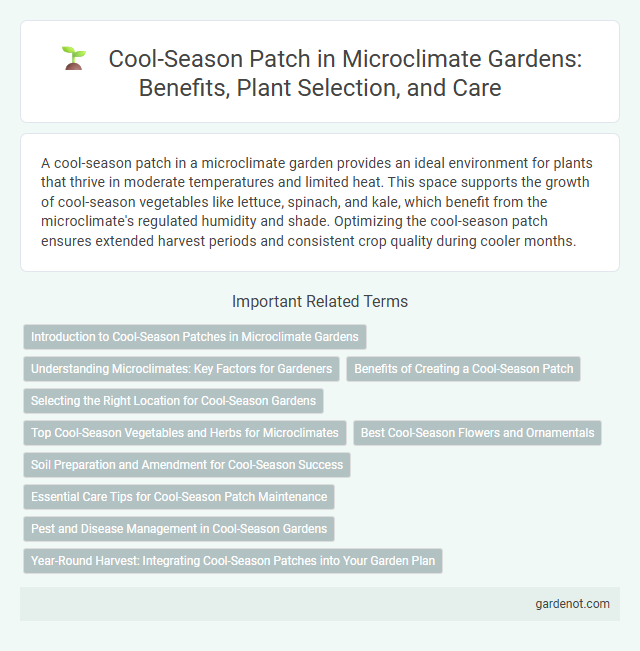A cool-season patch in a microclimate garden provides an ideal environment for plants that thrive in moderate temperatures and limited heat. This space supports the growth of cool-season vegetables like lettuce, spinach, and kale, which benefit from the microclimate's regulated humidity and shade. Optimizing the cool-season patch ensures extended harvest periods and consistent crop quality during cooler months.
Introduction to Cool-Season Patches in Microclimate Gardens
Cool-season patches in microclimate gardens thrive during lower temperature periods, leveraging shaded or protected areas to extend the growing season. These patches optimize microclimates by using soil insulation and strategic plant placement to maintain consistent moisture and prevent frost damage. Ideal crops for cool-season patches include kale, spinach, and broccoli, which benefit from cooler temperatures and reduced heat stress.
Understanding Microclimates: Key Factors for Gardeners
Cool-season patches thrive in microclimates where temperature fluctuations are minimal and soil moisture retention is high, creating an ideal environment for growth during cooler months. Key factors include sunlight exposure, wind protection, and soil composition, which collectively influence the thermal characteristics and humidity levels crucial for plant health. Gardeners can optimize cool-season patch success by analyzing and adapting to these localized environmental conditions.
Benefits of Creating a Cool-Season Patch
Creating a cool-season patch enhances garden productivity by enabling the cultivation of hardy vegetables like kale, spinach, and broccoli during colder months. This microclimate garden feature extends the growing season, reduces frost damage, and ensures a steady supply of fresh produce when outdoor conditions are less favorable. Incorporating shade, windbreaks, and moisture retention techniques maintains optimal temperatures and soil conditions for cool-season crops.
Selecting the Right Location for Cool-Season Gardens
Selecting the right location for cool-season gardens in a microclimate involves choosing areas with partial shade and well-drained soil to protect plants from intense summer heat. Ideal spots often include north-facing slopes, shaded courtyards, or sites with natural wind protection to maintain consistent moisture and cooler temperatures. Positioning near water features or using reflective surfaces can also help moderate temperature fluctuations and extend the growing season for cool-season crops like lettuce, spinach, and broccoli.
Top Cool-Season Vegetables and Herbs for Microclimates
Cool-season vegetables and herbs such as kale, spinach, and parsley thrive in microclimate gardens due to their tolerance for lower temperatures and extended growing seasons. These plants benefit from the specific temperature regulation and shelter provided by microclimates, allowing for healthier growth and higher yields during early spring and late fall. Incorporating broccoli, carrots, and cilantro also optimizes the cool-season patch by enhancing biodiversity and ensuring steady harvests in variable conditions.
Best Cool-Season Flowers and Ornamentals
Best cool-season flowers and ornamentals for microclimate gardens include pansies, violas, and snapdragons, which thrive in lower temperatures and provide vibrant color during early spring and fall. Other ideal choices are ornamental kale and dusty miller, known for their cold tolerance and striking foliage that enhances garden texture. Selecting these resilient plants ensures extended blooming periods and maintains aesthetic appeal in cooler microclimate conditions.
Soil Preparation and Amendment for Cool-Season Success
Prepare soil for a cool-season patch by testing pH levels, aiming for a range of 6.0 to 7.0 to support optimal nutrient uptake. Incorporate organic matter such as compost or well-aged manure to improve soil texture, moisture retention, and microbial activity essential for cool-season crops. Amend soil with balanced fertilizers rich in nitrogen and phosphorus to promote vigorous early growth and root development in cooler temperatures.
Essential Care Tips for Cool-Season Patch Maintenance
Maintaining a cool-season patch requires regular watering to keep the soil consistently moist, especially during dry periods, ensuring healthy root development. Mowing should be performed at the recommended height of 2 to 3 inches to promote dense growth and prevent weed invasion. Aeration and overseeding in the early fall enhance soil oxygen levels and repair any thinning areas, optimizing turf resilience through winter months.
Pest and Disease Management in Cool-Season Gardens
Effective pest and disease management in cool-season gardens involves regular monitoring for common pests such as aphids, cabbage worms, and flea beetles, which thrive in cooler temperatures. Implementing integrated pest management (IPM) techniques, including crop rotation, companion planting, and the use of biological controls like beneficial insects, reduces chemical reliance. Maintaining proper sanitation and optimizing airflow around cool-season patches helps prevent fungal diseases like powdery mildew and downy mildew.
Year-Round Harvest: Integrating Cool-Season Patches into Your Garden Plan
Cool-season patches thrive in microclimate gardens by extending the harvest into cooler months, utilizing plants like kale, spinach, and broccoli that tolerate lower temperatures. Integrating these patches into your garden plan ensures a continuous supply of fresh produce year-round, optimizing space and soil conditions for successive planting. Proper soil preparation and protection methods, such as mulching and using row covers, enhance plant resilience and yield through seasonal transitions.
Cool-season patch Infographic

 gardenot.com
gardenot.com